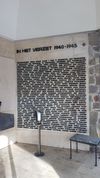

|
|
|
|
|
|
right wall, row 15 #03

Limburg 1940-1945,
Main Menu
The fallen resistance people in Limburg
Peter /Piet Roodbeen
(Pieter Jan)
∗ 31-12-1887 Sevenum † 18-02-1945 Salzgitter-Watenstedt (57)
- Forced Labor - Sevenum -

- Memorial Deportation Kronenberg
- 1. Reichswerke Hermann Goering, Wikipedia
• Nederlands • Deutsch • English • Français • Português
2. KZ Salzgitter-Watenstedt, Wikipedia • Deutsch
3. Friedhof Jammertal, Wikipedia • Deutsch
4. OpenStreetMap • Reppner ⇒ Leinde • Memorial Friedhof Jammertal
5. Reppner, Wikipedia D Lager 24 - Archief Oorlogsgravenstichting (@ Nationaal archief),
Dossier Pieter Jan Roodbeen • #14 • #18 - rijckheyt.nl Im Memoriam Pieter Jan Roodbeen
- Sevenum, monument aan het Julianaplantsoen
- Oorlogsgravenstichting.nl
Piet Roodbeen was a farmer. He was arrested in Kronenberg in the church raid of October 8, 1944. [1]
The Dienst Identificatie en Berging (Identification and Recovery Service) of the Ministry of Defense wrote on the archive card of Pieter Jan Roodbeen:
Arrested by the Germans on October 8, 1944 and landed at the Hermann Goering Werke in Watenstedt near Braunschweich. [2.1]
Died on February 18, 1945 in Watenstedt as a result of illness and exhaustion. Buried: Watenstedt cemetery, Jammertal field IV, row 14, grave number A
This archive card is now in the National Archives. [3#14]
Where did Pieter Jan Roodbeen die?
His family wrote on his death notice (in memoriam card) that he died in Reppner. [4]
This was the location of Camp 24, also known as Death Camp 24 [2.5], where people were taken to die from 1943 onwards. At least 633 people died in this camp between June 1941 and April 1945 and were buried in the Jammertal cemetery from July 1943. [2.5]
According to the aforementioned record card [3#14], however, he died in Watenstedt, i.e. in the Salzgitter-Watenstedt concentration camp, near the village of Leinde. The villages of Reppner and Leinde are 14 km apart. The Jammertal (Valley of Tears) cemetery lies between them. [2.4]
Up to 2,000 prisoners were held in the Salzgitter-Watenstedt concentration camp, near the village of Leinde near Salzgitter-Watenstedt. There they had to work in the Stahlwerke Braunschweig GmbH steelworks, which belonged to the aforementioned Reichswerke Hermann Göring. Grenades were manufactured there. An estimated 20 to 30 prisoners died every day under the deliberately inhumane conditions. At the beginning of 1945, the camp was used as a (death) camp for sick concentration camp prisoners from the Braunschweig region. At least 526 of them died in this camp alone and were buried in the cemetery for forced workers called “Ausländerfriedhof Jammertal”, near Salzgitter-Lebenstedt. [2.2]
Almost 5,000 forced laborers from all over Salzgitter were buried there. Today it is a memorial. [2.3]
Peter Roodbeen’s mortal remains were transferred to the Netherlands at state expense. [3#18]
They are now in the Roman Catholic cemetery in Kronenberg. [6]
His name is inscribed on the memorial in the green space Julianaplantsoen in Sevenum. [5]
Footnotes
 Memorial Friedhof Jammertal
Memorial Friedhof Jammertal